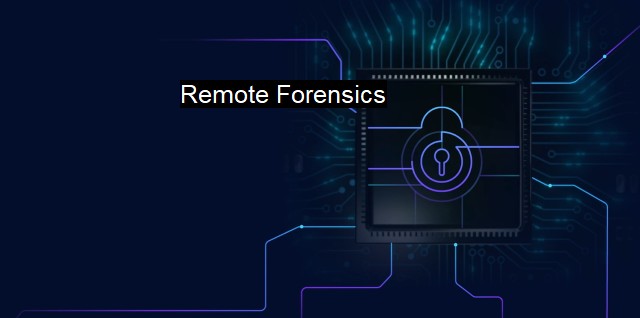What are Remote Forensics?
Understanding Remote Forensics: A Critical Cybersecurity Process for Investigating Cybercriminal Activities from a Distance.
Remote forensics, within the context of the cybersecurity and antivirus industry, represents a set of investigatory procedures groomed to establish and analyze electronic evidence without affecting its original integrity—especially when physical access to the suspect system is unfeasible, limited, or entirely impossible.The proliferation of digital transformation in the world of corporate and industrial sectors, and even amongst individuals, has led to the intensification of cyber-crime activities. Devices connected over the network, whether they be personal computers or smartphones, servers or other internet devices, are vulnerable to multiple forms of attacks capable of debilitating the digitalizal normality.
Cue in remote forensics, a fundamental and effective methodology to navigate the myriad of potential problems associated with these digital operations. Managing cybercrime activities in large networks is laborious when the only arrangement is physical acquisition of data. In many cases, the systems to be investigated can be located overseas, or perhaps too many devices are involved in disparate geographic locations. Unimpeded physical access may also be limited where court orders or suspects restrict forensic samples collection.
The applied mechanism of remote forensics—based on client-server architecture, comes bridging this gap making the process of forensic analysis easier and more efficient without the necessity for physical contact with the investigated device. The server here refers to the forensic analyst machine, while the client-side pertains to the suspect’s machine. The communication between both is typically secured through the use of advanced encryption algorithms.
Implementing remote forensics involves the application of automated scripts to identify suspicious activities, analyze malware, parse logs, take network snapshots, and even, when necessary, perform malware reverse engineering. This approach assists in capturing potential threats before they proliferate, fostering a better understanding of attack vectors, and facilitating the adaption of preventive measures that can thwart similar security breaches in the future.
An essential aspect of remote forensics that has contributed to its predominance over traditional forensics is the ability to execute live forensics. Traditional forensic methodology mandates the system be shut down to prevent any transformations in the data stored at the digital crime scene. powering down can also result in the loss of volatile data, which often contains pivotal clues about the nature of the cybercrime perpetrated.
Live forensics, part of the remote forensics methodology, ensures the ability to capture this volatile data—such as active network connections, running processes, and logged in users, creating a more comprehensive and detailed representation of the investigated incident—increasing the overall chances of resolving the cybercrime.
In the realm of remote forensics, time-effectiveness permeates—it involves significantly less time investment, owing to automated remote data collection, analysis and reporting. This reduces the ‘dwell time’ or the duration attackers have to exploit the vulnerabilities of a system, increasing the overall security effectiveness considerably.
Remote forensics in the context of cybersecurity and antivirus is a holistic procedure employing a well-structured sequence of escalating actions, coalescing the realms of digital forensics, incident response, malware analysis, threat intelligence and digital risk mitigation.
Evidently, deploying remote forensics offers a robust armor against modern-day cyber threats. While cyberattacks continue to grow more sophisticated, the powerful combination of mechanisms employed in remote forensics holds promise in cultivating a safer cyberspace, nurturing trust upon the realm of digitally coordinated commerce, finance, communication and entertainment. Through vigilant, continuous innovation and technological augmentations, remote forensics will continue to be indispensable in identifying, investigating, solving and preventing cybercrime incidents.

Remote Forensics FAQs
What is remote forensics?
Remote forensics is the collection of digital evidence for investigations that are conducted remotely, without the need for a physical presence at the location. It involves the use of specialized tools, software and techniques to examine and analyze digital evidence from remote devices.Why is remote forensics important in cybersecurity?
Remote forensics is crucial in cybersecurity because it allows investigators to gather evidence remotely from a compromised device or network, without the risk of further compromising the system or data. This enables rapid response to potential threats, the identification of vulnerabilities, and the prevention of future attacks.What are some common tools and techniques used in remote forensics?
Some common tools and techniques used in remote forensics include: network analysis tools, remote imaging, remote access software, live memory analysis, and data carving. Forensic investigators may also use virtual private networks (VPNs) and other secure communication channels to remotely access target systems.What are the ethical and legal considerations involved in remote forensics?
There are several ethical and legal considerations involved in remote forensics, including privacy concerns, digital evidence collection, chain of custody, and the admissibility of evidence in court. It is important to comply with applicable laws and regulations, as well as professional standards and ethical guidelines, when conducting remote forensic investigations.| | A | | | B | | | C | | | D | | | E | | | F | | | G | | | H | | | I | | | J | | | K | | | L | | | M | |
| | N | | | O | | | P | | | Q | | | R | | | S | | | T | | | U | | | V | | | W | | | X | | | Y | | | Z | |
| | 1 | | | 2 | | | 3 | | | 4 | | | 7 | | | 8 | | |||||||